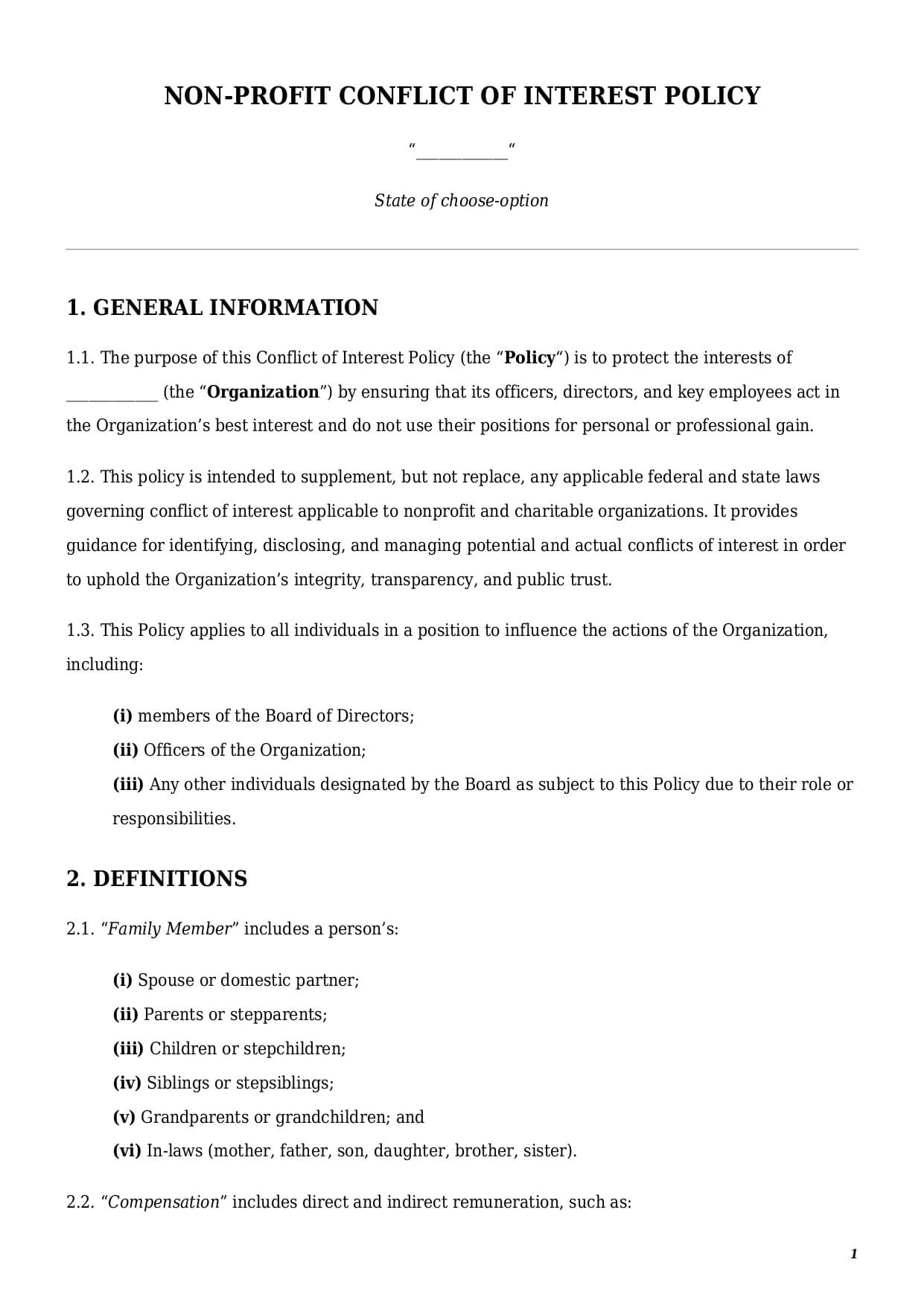Non-Profit Conflict of Interest Policy
Reviews


What is a conflict of interest policy?
A nonprofit conflict of interest policy is a formal document that helps ensure transparency, accountability, and integrity in the operations of a nonprofit organization. This is an internal roadmap for the organization’s officers, employees, and key staff dealing with the identifying, disclosing, and managing of conflicts of interest.
Common examples of conflicts of interest within nonprofit organizations may include:
- Board of Directors members voting on contracts involving companies they have shares in;
- The organization’s officers taking donations from third parties related to them (e.g., husband, in-laws, etc.);
- Hiring a director’s relative for a key position within an organization and much more.
There is no legal requirement on a federal or state level that requires a nonprofit organization to hold a conflict of interest policy. However, it is a good governance standard that:
- presents misuse of the organization’s funds;
- ensures compliance with the organization’s non-profit status; and
- maintains public trust.
After creation of a conflict of interest policy for a nonprofit organization, it should be signed to become a valid legal document. This policy could be signed by the organization’s CEO, secretary, either of the board’s directors, or other individuals within the organization. To find out who is responsible for signing this document, the best way is to first check the initial text of a nonprofit organization’s bylaws.
Top 5 Things to Include in a Nonprofit Conflict of Interest Policy Template
When drafting a nonprofit conflict of interest policy template, it is essential to include the following core elements:
Clear Definitions
The topic of a conflict of interest within every organization has a sensitive nature. Its correct application widely depends on the clarity of the policy’s provisions and applied wording.
Therefore, a nonprofit conflict of interest policy shall define terms such as “conflict of interest” and “potential conflict.” The best way to define them is by listing examples of all situations that may signify the existence of an interest between a party involved in a transaction and the organization’s interest.
Scope of Application
The text of the conflict of interest policy sample shall address the list of individuals to which this policy shall apply. The list may include only designated groups of individuals or cover everyone who is involved in the organization’s daily management or activity. For instance:
- directors of the Board;
- organization’s officers (e.g., CEO, treasurer, secretary);
- committee members (if such are being elected);
- key employees (e.g., head of legal department); or
- organization’s members (e.g., all or certain classes of membership).
Disclosure Procedures
Another important pillar every nonprofit conflict of interest policy should have is the disclosure procedure itself. A disclosure procedure is a step-by-step plan of actions a person involved in a conflict of interest should follow to disclose their conflict to the organization.
Usually a conflict disclosure could be of two types:
- annual (this is when, once a year, all individuals covered by the policy have to disclose their potential conflict of interest, if any, to an organization); and
- ad hoc (this is a special disclosure once a conflict of interest situation occurs).
The text of a nonprofit conflict of interest policy should clearly define to whom annual and ad hoc reporting should be submitted. On top of that, the procedure shall lay out the exact timeline within which such a disclosure should be made (e.g., immediately, within one week, etc.).
Consequences of Policy Violations
Every solid nonprofit conflict of interest policy provides detailed consequences for a policy’s violation. The consequences usually differ depending on the position an affected person held within the organization.
For instance, if it is an organization’s employee, a sanction may include termination of an employment contract. However, if this is an organization’s member who does not have employment relations with the organization, the termination of a membership might be one of the options.
All in all, it is possible to include the following consequences for a policy violation:
- termination of a membership;
- termination of employment relations;
- temporary suspension from a position (e.g., for a few weeks or months);
- temporary suspension from voting at the meetings (for members); or
- official warning.
How to customize a document template at Faster Draft?
To get a fully personalized template for conflict policy, follow a few easy steps below:
- Click the button “Create Document.”
- Answer simple questions in the form.
- Select a document’s format—PDF or Word.
- Make a payment.
- Download, print, and use a customized document in minutes.
Table of content

Looking for something Different?
Start typing to find out our collection of legal documents and contract templates
